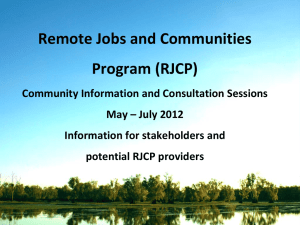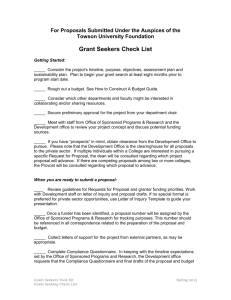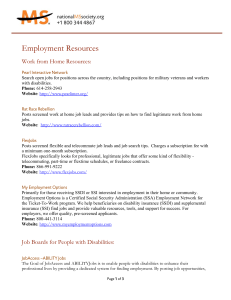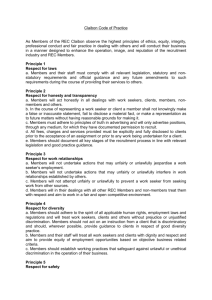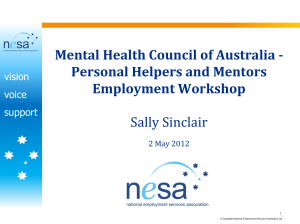Employment Services * building on success
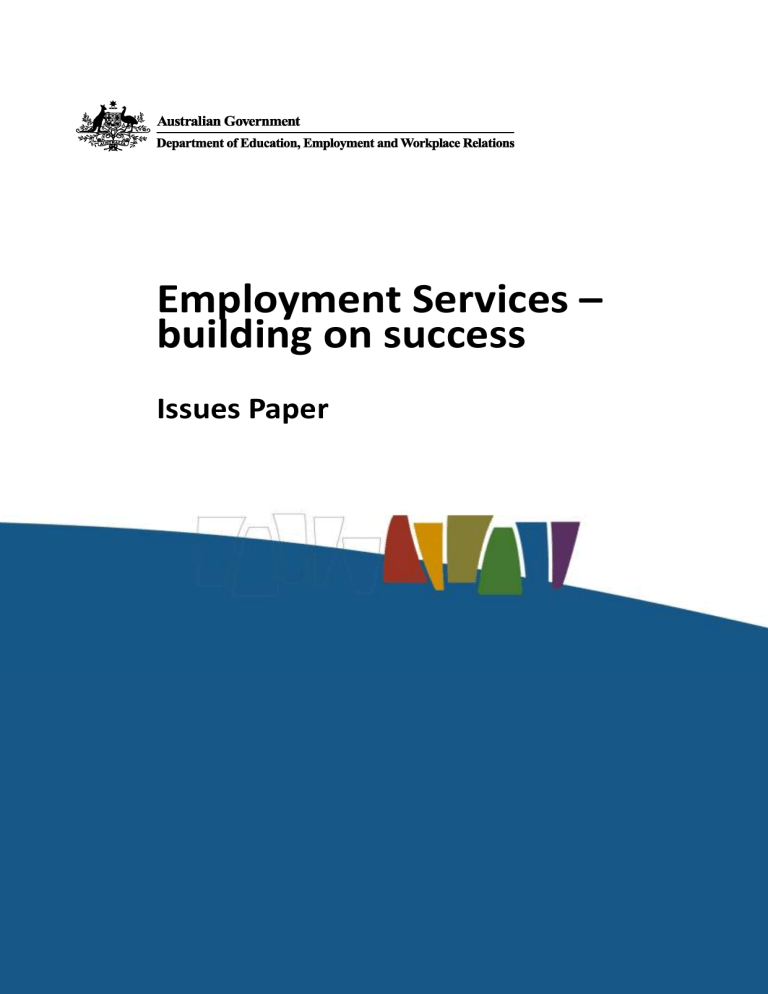
Employment Services – building on success
Issues Paper
ISBN
978-0-642-78703-3 [PDF]
978-0-642-78704-0 [DOCX]
With the exception of the Commonwealth Coat of Arms, the Department’s logo, any material protected by a trade mark and where otherwise noted all material presented in this document is provided under a Creative Commons Attribution 3.0 Australia
(
http://creativecommons.org/licenses/by/3.0/au/
) licence.
The details of the relevant licence conditions are available on the Creative Commons website
(accessible using the links provided) as is the full legal code for the CC BY 3.0 AU licence
(
http://creativecommons.org/licenses/by/3.0/au/legalcode
).
The document must be attributed as the Employment Services – building on success, Issues Paper.
3
Contents
Our current Employment Services System
4
Minister’s Foreword
Every Australian deserves the opportunity to work and every enterprise can be bolstered by the diversity of workers we have in this country. Workers contribute to the economy, pay taxes which boost services and experience the dignity and stability that a paying job provides.
Jobs are central to the Gillard Government and we are proud of our employment services and the improvement in real outcomes for job seekers since Labor came to government in 2007.
Job Services Australia (JSA) was established in July 2009 and Disability
Employment Services (DES) in March 2010 to make sure that the most vulnerable people received the attention they deserved to get them back into the workforce. We know that because of the new JSA model, people who would have fallen between the cracks have been helped into employment. Our success when it comes to getting Stream 4 job seekers – our most disadvantaged job seekers – into work has improved by 100 per cent when compared with the arrangements under the previous Government.
As I travel Australia, I am encouraged by the innovation I see amongst our hard-working community organisations, employment services providers, employers, trainers and job seekers who are collaborating on new and creative ways to secure sustainable jobs for those who are unemployed.
The Gillard Government will not shy away from making the hard decisions necessary to improve outcomes for Australian job seekers. Recently, the DES Employment Support
Service was put to its first full competitive tender to ensure Australians with a disability benefit from the very best providers. We are also in the midst of reforms to ensure that
Australians in remote areas also get the high-quality services they deserve.
The reform process is not over. While I am proud of the results we have achieved so far, it is essential that we keep our labour market strong and continue to improve our employment services system. As we prepare to deliver the next generation of employment services, let’s look at our strengths, identify best practices, recognise emerging pressures, and plan for the workforce needs of the next decade.
Through trials and pilot programs, Government has been investing in new ways of delivering employment services. We will carry these lessons forward as part of the review.
Over the last three and a half years, the Innovation Fund has contributed $41 million to over
80 new and creative projects to improve employment services outcomes. These programs have focused on better partnerships and coordination of services, as well as vocational and non-vocational barriers to employment. They include health improvement programs, youth literacy interventions, social enterprises, mentoring programs, specialist mental health programs, early intervention pilots, career choice and advice services, and many more.
In addition, through the 2011-12 Budget, we allocated $4.7 million for JSA Demonstration
Pilots. These 20 projects are focused on improving outcomes for the most disadvantaged job seekers. The focus of these programs includes homelessness, mental health, and drug and alcohol issues.
Our Wage Connect program, which provides subsidies to employers to get our long-term unemployed into jobs, has also been a strong success: securing a future for 13 000 people since January 2012.
5
This is an exciting time to take stock of what we have achieved, look critically at the outcomes of trials and innovations, encourage an open dialogue among stakeholders, and find out direct from those looking for work about the best way of doing things. How can we best identify employer needs? How can we build stronger partnerships? How can we get the balance right between the need for accountability of taxpayer funding and the time required for administrative work?
I want to hear from job seekers, employers, community groups and individuals who have new ideas that will help us design the best services to get people into meaningful and sustainable work.
Tell us your thoughts, share your good ideas and let’s make our employment services even better.
Finally, I would like to thank the members of the Government’s 2015 Employment Services
Reference Group whose work contributed to the development of this Issues Paper.
The Hon Kate Ellis MP
Minister for Employment Participation
6
1.
Introduction
Australia’s employment services are designed to assist people into employment by working with employers, training providers and job seekers to find individuals sustainable employment and where necessary address job seeker’s vocational and non-vocational barriers to employment.
The Australian Government currently invests around $10 billion over a four year cycle in employment services programs such as Job Services Australia (JSA), Disability Employment
Services (DES), Indigenous Employment Program and the proposed Remote Jobs and
Communities Program (RJCP). As a result of this Government’s decision to uncap employment services, at any point in time around 900 000 people are receiving assistance from JSA or DES providers, and over the course of a year, 1.6 million Australians will use JSA or DES services.
The contracts for JSA and the Disability Management Service (DMS) component of DES both expire on 30 June 2015.
The period leading up to that date provides a unique opportunity for widespread consultation. This will help the Government to put in place the most effective and flexible employment services model possible from July 2015. A model that is prepared for the likely labour market and will deliver tailored services to the groups of job seekers who are most likely to need assistance.
This issues paper starts the public consultation process. The section ‘How to have your say’ tells you how to get involved and how to make your submission.
Key themes that have been consistently raised with Ministers and the Department of
Education, Employment and Workplace Relations (DEEWR) and are covered in more detail in
Section 5 of this paper are:
meeting the needs of job seekers
working in partnership with employers
stronger partnerships with other services
new ideas for a better system, and
continuing to cut red tape.
In addition to seeking comments on the issues paper a number of forums will be held around Australia in early 2013 to capture the views of the Australian community.
DES - Employment Support Service which assists job seekers with a permanent disability and with an assessed need for ongoing support in the workplace has recently been re-tendered.
The new contract will run from March 2013 to June 2018 and as a result it is not the focus of this review.
The RJCP will help Australians in remote communities to get the skills they need to be work ready and to provide funding for projects that strengthen these communities and create real jobs. The RJCP will run from 1 July 2013 to June 2018 and as a result is also not the focus of this review.
7
2.
Our current Employment Services System
The OECD recently examined policies that are directed towards helping ensure that job seekers have a better chance of finding employment. Its review, Activating Jobseekers: How
Australia Does It, found that the Australian Government’s activation strategy has been successful in contributing to Australia’s increased employment rate. The OECD has praised
Australia’s employment participation programs finding that they have contributed to
Australia having one of the highest employment rates among G7 and OECD G20 countries.
Job Services Australia
In July 2009 the Government introduced JSA to help job seekers find and keep quality jobs. It focused particularly on those job seekers considered to have the greatest disadvantage as part of the Government’s social inclusion agenda. Subsequently the Government decided to retain the model and extend the contracts of high performing providers through to June
2015. The Government made this decision on the back of strong JSA performance.
JSA delivers services to around 700 000 job seekers at any point in time. There are currently
98 providers delivering services across 116 geographic locations across Australia.
Performance
The JSA system has achieved:
almost 1.4 million job placements between July 2009 and October 2012 including for over 230 000 people with disability, almost 236 000 job seekers who were 21 years and under, over 187 000 mature aged people aged 50 and over, plus more than
155 000 job seekers who identified as homeless, and
over 576 000 outcomes when a job seeker remained in work or education for
13 weeks and over 361 000 outcomes when a job seeker remained for 26 weeks.
Compared to the Job Network which operated prior to July 2009, JSA is getting significantly better results for job seekers; even against the backdrop of the Global Financial Crisis.
For the more ‘job ready’ job seekers who participated in JSA in the 12 months to 31 March
2012, the employment outcome rate around three months later was 52.3 per cent. This compares to an employment outcome rate of 50.6 per cent for people who participated in
Job Network in the 12 months to 30 June 2009.
JSA has performed particularly well in assisting those people with multiple barriers to employment. No longer is this group of job seekers left on waiting lists as was the case under the arrangements prior to JSA. If they are eligible, assistance is available immediately and this has resulted in the vastly improved employment outcomes for this group. Under
JSA, the employment outcome rate for the highly disadvantaged was 30.7 per cent. For those who were assisted under the program which previously serviced this group, in the
12 months to 30 June 2009, the employment outcome rate was 15.2 per cent. This represents a 100 per cent improvement in outcomes for the most disadvantaged job seekers, compared to the previous arrangements.
Disability Employment Services – Disability Management Services
DES commenced on 1 March 2010, following an extensive review of the previous disability employment programs. DES replaces the former Vocational Rehabilitation Services (VRS) and
Disability Employment Network (DEN).
Sixty-one providers deliver DES – DMS across 116 locations to around 75 000 job seekers with temporary or permanent disability, injury or health condition who require the assistance of a disability employment service, and who may require flexible, ongoing support but are not expected to need regular, long-term support in the workplace at any point in
8
time. DES-DMS replaced the former VRS program so comparisons are drawn between the two programs to determine program effectiveness.
The introduction of DES included an historic Government decision to uncap services so that for the first time, every eligible job seeker has immediate access to services to help them get and keep a job. There are no waiting lists. This is a significant step forward for people with disability.
Another key distinguishing feature of DES is that support can be offered to participants in the workplace for as long as it is required.
Performance
DES-DMS has performed better than its predecessor against most performance measures.
From 1 March 2010 to 31 October 2012, over 70 000 DES-DMS participants were placed into employment, over 47 000 were in a job 13 weeks later, and over 33 000 still in a job at the
26 week mark. Almost 41 per cent of participants are getting jobs under the DES-DMS program. This compares to 30 per cent for the previous system.
Comparing the number of job placements over a 32 month period, the current DES-DMS program has delivered more than a 100 per cent improvement on the previous programs.
This is a significant achievement.
The Evaluation of DES Interim Report, released in March 2012, also found that DES-DMS is achieving more sustainable employment outcomes for participants. The evaluation indicated post-program outcomes for DMS participants were ten percentage points higher than under the previous arrangements.
3.
Looking Forward
To ensure that employment services from 2015 deliver the best possible outcomes for
Australian job seekers and employers we need to make sure they take into account the shape and direction of the labour market, as well as keeping pace with structural changes in the Australian economy.
Labour Market
Over the last 30 years, the Australian labour market has undergone considerable structural change, which can be expected to continue through to 2015 and beyond. Labour market conditions have tended to fluctuate in line with changes in the business cycle. As illustrated in the chart below, with the onset of the Global Financial Crisis in September 2008, the unemployment rate increased from 4.0 per cent in February 2008 to reach a peak of
5.9 per cent in June 2009. Despite the ongoing uncertainty and volatility on global financial markets, sound economic and financial management has seen the unemployment rate decline to stand at 5.2 per cent in November 2012.
The last 30 years have also been marked by a notable rise in the labour force participation rate, which has increased from 61.1 per cent in October 1982, to stand at 65.1 per cent in
November 2012.
9
Unemployment rate (%) and participation rate (%), October 1982 to October 2012
12 67
1990's Recession
1980's Recession
11
66
10
65
9
64
8
7
6
5
4
3 Unemployment rate (LHS)
Bursting of the dot com bubble
Global Financial Crisis
Participation rate (RHS)
63
62
61
60
2 59
Source: ABS Labour Force, Australia (Cat. No. 6202.0), October 2012, trend data
Over the same period, the broader Australian economy has also changed significantly, becoming more service based and higher skilled. This structural shift is a result of technological change, globalisation, heightened competitive pressures and an ageing population. DEEWR projects an employment increase of nearly 830 000 over the five years to 2016-17. This will largely be driven by growth in service industries. Large increases in
Health Care and Social Assistance, Construction, and Professional Scientific and Technical
Services industries, together with continued strong growth in the resources sector, are expected to contribute almost two thirds of all employment growth in Australia over the next five years (or around 584 900 jobs).
Growth in these sectors is also changing the way we work, and changing therefore the nature of employment opportunities available to Australian workers. For example, many opportunities in the resources sector rely on workers who are prepared to commute on a
‘fly-in, fly-out’ or ‘drive-in, drive-out’ basis, residing only temporarily in regions close to job opportunities.
Occupational Skill Levels
Although the labour market is projected to generate employment opportunities across all skill levels and many occupations over the next five years, employment growth is expected to be strongest for higher skilled jobs. Employment in occupations commensurate with a
Bachelor degree or higher qualification is projected to increase by 322 500 in the five years to 2016-17, accounting for nearly two out of every five jobs created over this period. By contrast, employment in occupations commensurate with a Certificate I or compulsory secondary education is projected to grow by only 59 900.
The available evidence strongly suggests that further education and training improves employment outcomes. Generally, unemployment levels are lower and participation rates are higher for those with higher educational attainment.
It is important that employment services continue to focus on ensuring job seekers are given opportunities to undertake quality training that will allow them to increase their skill levels, if job seekers are going to be able to take advantage of an increasingly skilled labour force.
10
There is growing concern in the community about the potential for young people to ‘fall through the cracks’ and become disengaged and unemployed. Given the importance of education it is essential that young people be supported to make a successful transition from education to work.
Structural Challenges
Structural changes in the Australian labour market impact differently on different people.
New employment servicing arrangements need to embrace these groups of job seekers so they can fully contribute to the economic and social life of the community. The employment services system also needs to support increased participation for different groups so that we can benefit from higher productivity and future growth.
Young people are particularly vulnerable during periods of economic and labour market change, as they tend to have less education, skills and experience than their prime-age counterparts and are more prone to losing their jobs. As a result young people have higher unemployment rates.
Labour market conditions at the national level impact on other vulnerable groups, including jobless families and children growing up in jobless families. We need an employment services system that gives parents and young people the opportunity to find employment, thereby reducing the risk of intergenerational unemployment.
The mature age participation rate continues to increase. Older Australians now comprise a large and growing proportion of the labour force and take their jobs with them as they move into the older age cohorts. It is vital that policy be directed at encouraging employers to retain their older workers for longer, while at the same time assisting older groups currently outside the labour market to participate.
Regional Impacts
There are regional disparities in labour market performance and we need to ensure that the employment services can react and respond to changes in where jobs are.
4.
Innovation and Best Practice
We need to draw on the ideas of experts and the knowledge we have gained through the innovation and best practice projects and forums we have run since the JSA and DES programs commenced.
The Government has a range of initiatives to foster innovation and disseminate best practice amongst providers. The employment services sector has also shown leadership in this area though a range of pilots that are demonstrating how servicing strategies such as placing the job seeker at the centre of collaborative service arrangements can improve outcomes for job seekers.
The Government has demonstrated a strong commitment to working with the community and providers to explore how employment services can contribute to the Government’s social inclusion goals. This commitment will continue.
Over the past two years the Government has committed $20 million for a Local Employment
Coordinator Flexible Funding Pool. Local Employment Coordinators (LECs) work with local
Advisory Committees, employers, employment services and training providers and the community sector to identify projects or activities that respond quickly to local needs and maximise employment and training opportunities.
11
The Government has established high profile independent bodies, including:
the Prime Minister’s Council on Homelessness, and
the Australian Social Inclusion Board both of which have been charged with reporting to Government on their views on how to focus employment services from 2015.
In addition, the Advisory Panel on Positive Ageing, which has the role of leading a national dialogue on ageing issues, improving coordination of policy design across portfolios, and working with the Government on implementation and design of ageing policy, has been asked for its views on how employment services can best assist mature age job seekers. The
Consultative Forum on Mature Age Participation has reported to the Government and a number of recommendations has already been implemented. The Government will be further considering the Consultative Forum’s report and recommendations as part of this review.
The Government has also funded a number of programs to highlight best practice arrangements in employment services and explore innovative best practice ways of assisting job seekers. These include:
the Innovation Fund which resulted in $41 million being invested in 83 projects between 2009 and 2012
the JSA Demonstration Pilot Program where $4.7 million is being spent on 20 projects, and
joint interactions in 14 locations between employment services providers, community partners, job seekers and the Department of Human Services through
Local Connections to Work and Connections Interviews.
Analysis of outcomes from the Innovation Fund and JSA Demonstration Pilots play a key role in the review. More information about the pilots is available at www.deewr.gov.au/job-services-australia-demonstration-pilots .
Apart from regular and ongoing dialogue with employment services providers, the
Government has also regularly engaged with the community to seek their views and to ensure that the great work that is already being done by many organisations to assist job seekers is highlighted and is shared as broadly as possible.
Migrant and refugee roundtable meetings have been held with community representatives and employment service providers to allow communities and providers a direct line of feedback to Ministers about what can be done to improve employment services in the short, medium and long term.
The Government is also convening a series of better practice forums to allow JSA and DES providers and other services to identify how they can best work collaboratively for the benefit of job seekers. The forums are helping to disseminate innovative and effective practices and are leading to improved relationships between JSA providers and complementary services.
The issues raised through these consultative forums, and the better practices identified though the forums and pilots, will be central to the Government considering how employment services arrangements will operate from 2015.
12
JSA Demonstration Pilots
The JSA Demonstration Pilots are exploring how to bring stronger service delivery models to improve outcomes for the most highly disadvantaged job seekers.
Example 1
One pilot is trialling a clinical case management model that co-located qualified and experienced human service professionals (such as social workers and psychologists) alongside employment services. The pilot is showing improved attendance rates and increased job seeker placements. The pilot has done this through a model that delivers comprehensive face to face assessments, increases the frequency of contact between job seekers and providers, and involves flexible arrangements (such as home visits, group workshops and mentors). The pilot is demonstrating that JSA providers can support improved service coordination in a local area, place job seekers’ goals at the centre of activities and improve sharing of best practice between different providers. The success is due to job seekers being involved in the planning of their case management and developing stronger relationships with complementary service providers (for example, mental health services) to ensure that all barriers to employment are addressed.
Example 2
Another two pilots are working to improve outcomes for homeless job seekers using joint case management models to improve and facilitate interactions between employment and accommodation services. One of these pilots is showing that improved assessment processes lead to more meaningful activities that better respond to the overall needs of the job seeker. Better identification on needs up-front has improved attendance and outcome rates. Strong linkages with community organisations are helping support an individual with housing, health care or social support that has a real impact on securing a job and keeping it longer.
5.
Building on Success
Under JSA and DES, job seekers, particularly the most disadvantaged, are being helped into employment at rates much higher than under the previous employment servicing arrangements. The OECD has recognised this achievement. However, the Government is committed to doing more to help disadvantaged unemployed people into sustainable employment.
Meeting the needs of job seekers
Job seekers need to receive the most appropriate assistance, support, training and opportunities to help them find sustainable employment. Employment services must be flexible enough to provide assistance to people with a diverse range of needs and who face different circumstances.
13
Current situation
The current system provides services tailored to the level disadvantage of individual job seekers. The most disadvantaged job seekers receive the most support and funding in recognition of their high barriers to employment.
Both JSA and DES providers are contractually required to deliver individualised tailored assistance to all job seekers, taking into account that some job seekers experience greater disadvantage than others.
Following a job placement, some job seekers are more likely to remain in work than others.
Current results show that on average, 70 per cent of job seekers who are placed into a job by their JSA provider are still employed three months later. Sole parents achieve strong outcomes (81 per cent are still employed three months after a job placement) with most working part-time to suit their circumstances, while others such as Indigenous or homeless job seekers are less likely to be employed three months after a job placement (around
60 per cent).
Under JSA and DES-DMS there are specialist providers who assist defined groups of job seekers.
There are 53 JSA providers who are contracted to deliver specialist services for job seekers who are young; have a disability; have mental health problems; are culturally and linguistically diverse (CALD); are refugees; are homeless or at risk of homelessness; are
Indigenous Australians; or are ex-offenders. There are 19 DES-DMS providers contracted as specialists with 224 sites across Australia.
Issues
Some groups of disadvantaged job seekers, particularly migrants, refugees, the homeless, and people with disability, tend to remain unemployed considerably longer than less disadvantaged job seekers.
As a result of the Global Financial Crisis, the number of people who have been unemployed for more than a year and those who have been unemployed for more than two years have grown. Historically numbers tend to stay high for a period after a softening in the labour market, so it is likely that there will still be a proportion of job seekers who have been unemployed for at least a year by the time the new model commences.
The identification and appropriate servicing of people who are at-risk or homeless has been, and is expected to continue to be, a key focus of the Prime Minister’s Council on
Homelessness. While JSA outcomes continue to improve for homeless job seekers, numbers of homeless people using JSA continue to grow.
Indigenous unemployment remains higher than for other groups of job seekers and our system needs to continue providing tailored programs for Indigenous job seekers.
People with disability also experience higher unemployment. The range of service options for a job seeker with disability include JSA, DES-DMS or other interventions and this can be confusing for job seekers and providers.
Some stakeholders have raised concerns about whether the operation of the Job Seeker
Classification Instrument (JSCI) and Employment Services Assessment (ESAt) accurately reflect some job seekers’ level of disadvantage, particularly if they are unwilling to disclose personal information to the Department of Human Services and providers.
Feedback from migrant and refugee communities has highlighted that CALD job seekers face a range of barriers to employment that could be better addressed. English language
14
proficiency is seen as a major barrier to employment that needs to be more effectively addressed, with more of a focus on ‘English for work’.
The Global Financial Crisis also had a disproportionate impact on young people with greater job losses and higher levels of unemployment than for older workers, and we need to ensure we meet the literacy and numeracy training, work experience and support needs of this group into the future.
We also need to ensure that intergenerational unemployment does not become entrenched.
Young people whose parents are not working have lower participation and higher unemployment rates than young people with at least one parent in work.
Our ageing population will also be an important factor over the next decade and employment services must also adapt to meet the needs of this group.
Feedback from specialist providers is that having to deliver services to job seekers not in the group they are focused can create difficulties. On the other hand, some job seekers have raised concerns that if they work with a specialist provider they may be stigmatised by employers and it may reduce their chances of finding a job. We need to make sure our system gets the balance right in accommodating specialist providers.
For Discussion
How can we ensure that individual job seekers from all backgrounds and levels of disadvantage get the services that best meet their needs?
How should specialist services best be structured and incentivised to ensure they most effectively reach the largest number of job seekers?
What role can employment services play in breaking entrenched or intergenerational unemployment?
How can employment services work with the Department of Human Services and other services which support families to improve outcomes for job seekers?
Working in partnership with employers
Employers are the engine room of economic activity and job creation. Meeting the needs of employers must be central to the employment services system.
A major challenge of employment policy is how to inform employment services providers of the skill and workforce development needs of employers and how job seekers can access the appropriate support and training to meet their needs.
Current situation
The objective of the employment services model is to help individuals to obtain the skills they need and to secure sustainable employment. It is also expected to meet the needs of employers who are looking to fill jobs.
In 2012, at any one point in time, there has been an average of around 11 500 jobs on the
Government-funded jobs board, Australian JobSearch.
Under current arrangements providers can offer a range of Government subsidies to encourage employers to participate and to cover the cost of taking on a person who may not initially be as productive as someone with more relevant work experience. Many providers already enter into successful arrangements with employers particularly at the local level with small and medium employers.
15
Issues
While providers are placing significant numbers of job seekers into work, more could be done to partner with employers. A recent random sample of Australian businesses shows that only around two-thirds of employers are aware of Government-funded employment service agencies and that they provide a free service to help employers find staff. Of these employers, only 7 per cent of them had used JSA and 3 per cent had used DES in the previous 12 months.
The same survey showed that employers were less willing to hire people who had been unemployed for a long time (71 per cent) because of concerns about attitude, work ethic, reliability, motivation and consistency. Employers also indicated a reluctance to recruit people with disability (54 per cent) because of concerns relating to physical inability to perform the role or uncertainty regarding the nature of the disability. We want a system that works more effectively with employers to increase their appreciation of the benefits of and business case for, employing the long-term unemployed, people with disability and other disadvantaged job seekers.
In qualitative research undertaken as part of the survey, employers who reported unsatisfactory experiences using employment service providers generally expressed frustration with the quality of the candidates referred to them and communication with the employment services provider. They also often felt that there was a mismatch between the level of support sought and the level of service received. This points to a need to more closely engage with employers to ensure that job seekers are prepared with the skills and attributes that employers need. Large employers also seem to prefer direct partnerships to meet their recruitment needs and tend to shy away from working with a large number of recruitment companies or employment services providers.
The Australian Government recognises the importance of workforce development to the
Australian economy. However, typically employment service providers have focused on assisting employers to fill vacancies, rather than building relationships with employers to help them with their longer-term workforce needs. In addition, many employers have difficulty finding the workers they need, even for low-skilled and entry level jobs. Filling this gap is a significant opportunity for employment services.
For Discussion
What strategies could be used to increase employer awareness of the employment services system and the workforce development and business benefits it can provide?
How should the employment services system best meet the workforce needs of employers?
How can employment services build stronger partnerships with employers to achieve sustainable employment outcomes?
How could large employers – with many work sites – partner most effectively with employment services? How can employment services providers partner with small and local employers?
How can employment services providers contribute to overcoming national and regional labour and skills shortages?
16
Stronger partnerships with other services
The success of employment services is reliant on how effectively providers work with other services, including the Department of Human Services. Experience shows that disadvantaged job seekers benefit most from a wrap-around holistic approach.
Current situation
In order to provide effective assistance to job seekers, employment services need to form effective partnerships with other services. Many job seekers face barriers that are not directly related to skills or employment, and therefore require assistance beyond that provided at training and employment organisations.
Employment services programs form part of a broader suite of programs that providers can tap into to assist job seekers including:
homeless, drug and alcohol, mental health services, domestic violence, housing and other services
language literacy and numeracy programs
employment programs specifically targeted at Indigenous job seekers
programs targeted specifically at mature aged job seekers
accredited training funded under the Commonwealth/State National Partnership
State and Territory funded training, and
programs which support small business start-ups.
Issues
There has been strong feedback about the disconnect between employment services and other complementary services. The next employment servicing arrangements need to better encourage partnerships with other services, including the Department of Human Services, and to deliver holistic servicing to job seekers.
We know, through the JSA Demonstration Pilots and other initiatives, that partnerships reduce duplication, encourage innovation and holistic servicing, and result in improved results for job seekers. The Government would like to encourage a constructive conversation on how to build partnerships with other services, particularly around how to:
improve coordination and sharing of resources between employment services providers and complementary services
improve coordination between employment service case managers and complementary service case managers, where a job seeker is receiving assistance from both sources, and increase awareness of the full range of Commonwealth and
State/Territory assistance available to both job seekers and their providers.
For Discussion
How can the employment services system be structured to encourage partnerships with a wide range of other organisations to meet the needs of job seekers?
How can we ensure that partnerships effectively reduce duplication and free up more resources for job seekers?
How would partnerships between training providers and employment services most effectively improve outcomes for job seekers?
How can the relationship between employment services and the Department of Human
Services be improved to better assist job seekers?
17
New ideas for a better system
The way Government designs the employment services system from 2015 will have a significant influence on how quickly job seekers are assisted into sustainable employment and the extent to which employers can rely on employment services to meet their recruitment needs.
Current situation
JSA and DES-DMS are both competitive models and providers are contracted via a tender process. There are generally more than two providers in each defined geographic area to provide job seekers with choice and to encourage continuous improvement. Multiple providers can however lead to confusion for job seekers and employers. Some employers report being over-serviced by too many providers being in the one region.
Both programs use outcome payments and formal performance rating systems to incentivise and reward providers. This is a very important element of the model as it ensures higher rewards for placing the most disadvantaged into work and reduces the risk of the harder to place job seekers being ‘parked’.
While providers are required to deliver individualised tailored services to job seekers, they do so within a contractual framework that is consistent across the country. In response to
Australian and international evidence about the effectiveness of place-based servicing, the
Government has introduced this model in a range of communities across Australia, based on their level of disadvantage. The Government has appointed LECs in 20 Priority Employment
Areas. LECs are successfully working in collaboration with employers, community groups and all levels of government to help develop local solutions to meet local labour market needs.
Place-based servicing involves private and public (across all levels of government) stakeholders working together to develop and deliver services and generate employment opportunities, that are specific to a particular geographical area.
There is also an increasing emphasis on building the capacity of providers. DEEWR provides extensive online training modules for employees of employment services providers through a Learning Centre. DEEWR updates these training modules on a regular basis and delivers online ‘LiveMeets’ where departmental officers train providers about new policies and changes to the program.
From 2015, all contracted providers will be required to be accredited against a DEEWR approved standard which will include requirements for recruitment, management and professional development of staff. Providers will also be externally assessed annually against these standards. DES providers have a set of standards (the Disability Services Standards) they must be certified against in order to keep their funding to deliver services.
Issues
There is broad agreement that the performance management system and the outcome payment structure drive improvements in services and deliver employment outcomes for job seekers. Some stakeholders, however, maintain that while the system is very good at delivering short-term outcomes, there is a need to ensure they translate into long-term employment.
The star ratings system is acknowledged by the OECD as among the best rating mechanisms in the world for driving performance. However, we need to ensure that it keeps pace with our policy goals and the changing labour market.
While there are clear efficiency and performance benefits from a competitive employment services model, experience has shown that it does not always encourage collaboration or
18
the sharing of best practice and innovation. We want to ensure that all job seekers can benefit from the most effective and efficient practices.
In addition, contracts and payment structures have limited cooperation across geographic areas, and have not always resulted in the best opportunities or long-term sustainable results for job seekers.
A highly skilled employment services workforce is critical to the delivery of high quality employment services and achieving high employment outcomes for job seekers. Many providers recognise this and have implemented workforce development strategies. Despite this, not all providers have in place strategies to develop their employees and future workforce.
Less Red Tape
The Government is committed to reducing the compliance burden of the current employment services system, while maintaining strong accountability for the use of public money.
The Government established the Advisory Panel on Employment Services Administration and Accountability (APESAA) which reported in September 2012. The Advisory Panel’s Final
Report made a range of recommendations on how the employment services model can be streamlined and improved while maintaining accountability. These included: administration simplification, contract architecture, workforce development for providers, encouraging innovation, emphasising sustainable employment outcomes, industry standards, and development of a new assurance framework.
The Government has noted and supported a number of the Final Report’s recommendations and is considering these in the context of employment services in 2015 and beyond. The
Government has already taken action on a number of these recommendations.
The implementation of the Job Services Australia Quality Standards Pilot will enable providers and DEEWR to work together to finalise the operational detail of the framework for a model for assessing providers’ delivery of quality services, including certification against an acceptable industry standard.
DEEWR continues to work with industry about the ongoing refinement of its approach to program assurance, including adopting a targeted approach based on specific areas of program and provider risk.
For Discussion
How can collaboration between providers be fostered while maintaining the benefits of a competitive employment services model?
How can innovation be fostered, rewarded and communicated across the employment services sector?
How should payments for delivering employment services be structured to strategically build the skills and employability of job seekers, and deliver sustainable employment outcomes?
What is the most effective way to measure the success of the employment services system?
What role should place-based solutions play in the future?
How can providers and Government ensure that the employment services workforce is appropriately skilled, and well placed to deliver excellent services?
19
How can red tape be further reduced without compromising accountability for the expenditure of public funds?
Other areas for consideration
While this paper has focused on some key themes to help frame responses, feedback on other aspects of employment service arrangements that you think could improve assistance to job seekers and employers is encouraged.
In a labour market characterised by a geographic mismatch of labour and skills, there is a need to consider new ways to help people to move to other locations where employers are having difficulty filling jobs. As the Australian economy continues to undergo structural changes, we also need to ensure that our employment services system is flexible to match people, skills and places.
There have been calls for career development assistance so job seekers are better placed to develop a career after they find a job. We are also interested in your views on the role of
Government, including the Department of Human Services, and new technology such as the
National Broadband Network in service delivery and raising awareness of the range of support available to people.
For Discussion
What can be done to encourage job seekers to move to other locations where they are more likely to get jobs?
How can job seekers best be assisted with career development? What role should employment service providers play?
How can modern technologies such as social media tools and the National Broadband
Network be harnessed to improve the way employment service providers provide services to job seekers and employers?
20
6.
How to have your say
Written submissions
You are invited to make a written submission in response to the issues paper. The paper contains key themes that are critical to the design and operation of employment services, and provides discussion points to assist stakeholders with their submissions. However, submissions are welcomed on any relevant matter and do not need to address all, or any, of the questions posed in this paper.
We prefer that submissions are emailed to: 2015EmploymentServices@deewr.gov.au
Alternatively, they may be faxed to (02) 6276 7346 or posted to:
Director
Employment Services Beyond June 2015
GPO Box 9880
CANBERRA ACT 2601
Location Code C50MA4
Written submissions should be lodged by 5 pm Friday 15 March 2013.
Further consultation and next steps
The Government will undertake broad consultations with stakeholders and other interested people from early 2013. This will include a series of forums hosted by DEEWR. Feedback from these forums will be taken into account as part of the review.
The Government is also committed to engage directly with job seekers and to hear their views on the future of employment services.
Along with a broad range of independent submissions, the advice of the Prime Minister’s
Council on Homelessness, the Australian Social Inclusion Board, the Advisory Panel on
Positive Ageing and the 2015 Employment Services Reference Group will also be taken into account. In addition, an independent analysis of JSA performance will be undertaken, and a consultation analysis will be made available.
Further details and the schedule of consultation forums will be posted at www.deewr.gov.au/employmentservices2015 as they become available.
Questions
Should you have any questions please send an email to
2015EmploymentServices@deewr.gov.au
21
Publishing submissions
Publication
The Department of Education, Employment and Workplace Relations (‘the department’) may publish all submissions for public review on the department’s website and may include submissions in reports or materials published by the department.
All submissions will be thoroughly reviewed by the department, and this may delay posting to the department’s website.
Submissions will be uploaded to the department’s website progressively as they become available in an accessible format.
All submissions will be made public unless the author states in writing that their submission is confidential.
The department reserves the right to edit or redact a submission, or withhold a submission from publication, if it believes that the content of the submission is defamatory, offensive, contravenes anti-discrimination or anti-vilification law or otherwise breaches any law.
Privacy
Personal information collected from submission authors is managed under the Privacy Act
1988. The department will collect personal information from submission authors for the purposes of developing a new model for employment services beyond June 2015. Any personal information collected will only be used by the department for this purpose. By making a submission to this review you are consenting to the disclosure of your personal information by the department through publication of your submission on the department’s website. Personal information within your submission may also be disclosed by the department in related reports or material published by the department. The personal information collected will not otherwise be disclosed without your consent, unless authorised or required by law.
Freedom of Information
The Freedom of Information Act 1982 (‘FOI Act’) applies to all documents in the possession of the department. The FOI Act gives the Australian community access to information held by the government by providing for a right of access to documents. This includes any submissions provided to the department for developing a new model for employment services beyond June 2015, including any submissions which have been provided on a confidential basis. A decision regarding access to documents under the FOI Act will be made by an authorised FOI decision-maker in accordance with the requirements of the FOI Act.
Submissions which are requested under the FOI Act may also be published on the department’s disclosure log, in accordance with the publication requirements of the FOI Act.
Copyright
Ownership of all intellectual property rights vest in the author of a submission. The author grants to the Commonwealth a permanent, royalty-free licence to use and adapt material contained in a submission, including publication on the department’s website.
22
23
